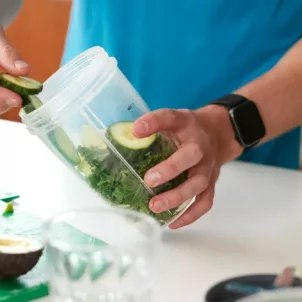THE WELLNEST • Healthy Eating
5 Healthy Foods to Support Digestion & Gut Health
By Julie Biegner •
March 17, 2016
Today our nutritionists are sharing the five gut-friendly nutrients and probiotic foods that help balance digestion. To help achieve a strong and healthy digestive tract, our nutritionist also designed a DIY yogurt recipe for you to make your very own probiotic foods!
 Cruciferous vegetables are a great foundation for a healthy digestive tract. These include broccoli, Brussels sprouts, kale, and collard greens. They’re rich in fiber and packed with healthy vitamins and minerals.
When it comes to the gut, these fiber-packed greens help regulate digestion and allow healthy bacteria to flourish. One study found a compound in green cruciferous veggies boosts the immune system and activates a gene called T-bet. Researchers in Australia found this gene lives in the gut and actually triggers the growth of healthy bacteria in the GI.
Although cruciferous veggies have some great nutrients to feed your GI, they also contain a compound called cellulose that our bodies naturally have a tough time digesting. That’s why for some, eating raw veggies can lead to gas, bloating, or abdominal pain. If your diet doesn’t currently include many greens, or if you find these are rough on your GI, there are a few things you can do. Incorporating raw greens into your diet gradually over time, and cooking or fermenting your veggies can all be beneficial to ease their route in the digestive tract while still nourishing your colon.
For some, taking a daily digestive enzyme that includes cellulase, an enzyme produced naturally by intestinal bacteria to digest cellulose, can help break down the fiber in cruciferous veggies to make it easier on your GI tract.
Cruciferous vegetables are a great foundation for a healthy digestive tract. These include broccoli, Brussels sprouts, kale, and collard greens. They’re rich in fiber and packed with healthy vitamins and minerals.
When it comes to the gut, these fiber-packed greens help regulate digestion and allow healthy bacteria to flourish. One study found a compound in green cruciferous veggies boosts the immune system and activates a gene called T-bet. Researchers in Australia found this gene lives in the gut and actually triggers the growth of healthy bacteria in the GI.
Although cruciferous veggies have some great nutrients to feed your GI, they also contain a compound called cellulose that our bodies naturally have a tough time digesting. That’s why for some, eating raw veggies can lead to gas, bloating, or abdominal pain. If your diet doesn’t currently include many greens, or if you find these are rough on your GI, there are a few things you can do. Incorporating raw greens into your diet gradually over time, and cooking or fermenting your veggies can all be beneficial to ease their route in the digestive tract while still nourishing your colon.
For some, taking a daily digestive enzyme that includes cellulase, an enzyme produced naturally by intestinal bacteria to digest cellulose, can help break down the fiber in cruciferous veggies to make it easier on your GI tract.
 Chia seeds are rich in antioxidants, omega-3 fatty acids, minerals, and vitamins for a plethora of health benefits. For digestion, the best nutrients here will be fiber: just two tablespoons of chia seeds supply 10 grams of fiber. Flaxseeds additionally are a great source of dietary fiber, helping to increase bowel movements and prevent constipation.
When it comes to fiber, your body needs both insoluble (meaning it doesn’t dissolve in water and isn’t broken down in your GI) and soluble (which does dissolve in water). Dietary fiber is essential to healthy digestion, and it’s a nutrient many of us do not get enough of. It helps keep bowel movements regular, bulks up stools, prevents constipation, and flushes out waste. Studies show that the way bacteria digests fiber also helps produce short-chain fatty acids that are healthy for the colon.
Because of the way it works in the body, it’s important to drink plenty of water along with fibrous foods in order flush out waste and prevent constipation. However, too much fiber can lead to loose stools, bloating, or diarrhea—so ensure you’re always consuming in moderation.
Chia seeds are rich in antioxidants, omega-3 fatty acids, minerals, and vitamins for a plethora of health benefits. For digestion, the best nutrients here will be fiber: just two tablespoons of chia seeds supply 10 grams of fiber. Flaxseeds additionally are a great source of dietary fiber, helping to increase bowel movements and prevent constipation.
When it comes to fiber, your body needs both insoluble (meaning it doesn’t dissolve in water and isn’t broken down in your GI) and soluble (which does dissolve in water). Dietary fiber is essential to healthy digestion, and it’s a nutrient many of us do not get enough of. It helps keep bowel movements regular, bulks up stools, prevents constipation, and flushes out waste. Studies show that the way bacteria digests fiber also helps produce short-chain fatty acids that are healthy for the colon.
Because of the way it works in the body, it’s important to drink plenty of water along with fibrous foods in order flush out waste and prevent constipation. However, too much fiber can lead to loose stools, bloating, or diarrhea—so ensure you’re always consuming in moderation.
 Prebiotics differ from probiotics in that they contain indigestible nutrients that promote the growth and success of the healthy bacteria (hence the pre). Probiotics are those beneficial bacteria that support your digestive system, so protecting their growth and diversity is an important job! Prebiotics and probiotics work synergistically to promote the well being of your GI and keep your body healthy.
Some especially gut-friendly fruits and veggies include the prebiotics found in asparagus, artichokes, mushrooms, onions, apples, and bananas. Inulin, a nutritional component that occurs naturally in many of these fruits and veggies, is full of fiber and low in calories. The fiber in inulin is soluble, and dissolving in the stomach to slow digestion and increase fullness.
Prebiotics differ from probiotics in that they contain indigestible nutrients that promote the growth and success of the healthy bacteria (hence the pre). Probiotics are those beneficial bacteria that support your digestive system, so protecting their growth and diversity is an important job! Prebiotics and probiotics work synergistically to promote the well being of your GI and keep your body healthy.
Some especially gut-friendly fruits and veggies include the prebiotics found in asparagus, artichokes, mushrooms, onions, apples, and bananas. Inulin, a nutritional component that occurs naturally in many of these fruits and veggies, is full of fiber and low in calories. The fiber in inulin is soluble, and dissolving in the stomach to slow digestion and increase fullness.
 We spoke at length about the plethora of probiotic probiotic health benefits and how to choose the best probiotic for you in the past. Probiotics help keep your digestion stable and supports the absorption of nutrients. They also help supported a disrupted microbiome after taking antibiotics and can support everything from immunity to healthy skin or even vaginal health.
Fermented foods contain lactic acid-producing bacteria, which survive the acidic digestive process into your colon. For plant-based options, look to fermented veggies for natural probiotic foods. (We have a complete guide to the best and worst probiotic foods here.) Go for sauerkraut, a fermented cabbage—but avoid the canned kind, as it’s pasteurized and the healthy bacteria is killed off. Also try kimchi—a staple at any Korean BBQ—a spicy fermented cabbage and rich probiotic. It’s particularly beneficial for your immune system. Kombucha, a fermented tea, is another popular probiotic.
We spoke at length about the plethora of probiotic probiotic health benefits and how to choose the best probiotic for you in the past. Probiotics help keep your digestion stable and supports the absorption of nutrients. They also help supported a disrupted microbiome after taking antibiotics and can support everything from immunity to healthy skin or even vaginal health.
Fermented foods contain lactic acid-producing bacteria, which survive the acidic digestive process into your colon. For plant-based options, look to fermented veggies for natural probiotic foods. (We have a complete guide to the best and worst probiotic foods here.) Go for sauerkraut, a fermented cabbage—but avoid the canned kind, as it’s pasteurized and the healthy bacteria is killed off. Also try kimchi—a staple at any Korean BBQ—a spicy fermented cabbage and rich probiotic. It’s particularly beneficial for your immune system. Kombucha, a fermented tea, is another popular probiotic.
 In addition to fermented vegetables, cultured dairy products such as yogurt, kefir, and cheese are probiotic foods to support digestion. Kefir—a drinkable yogurt—contains complex carbs that feed healthy bacteria. Greek yogurt is additionally packed with protein to help you feel fuller, longer. Whenever buying from a supermarket, look for plain flavors with little to no added sugar.
Also, make sure live and active cultures are actually included on the label. Heat processing destroys both bad and good bacteria. Thus, the pasteurization process in yogurt will kill off the good guys unless they’re added in afterwards.
In addition to fermented vegetables, cultured dairy products such as yogurt, kefir, and cheese are probiotic foods to support digestion. Kefir—a drinkable yogurt—contains complex carbs that feed healthy bacteria. Greek yogurt is additionally packed with protein to help you feel fuller, longer. Whenever buying from a supermarket, look for plain flavors with little to no added sugar.
Also, make sure live and active cultures are actually included on the label. Heat processing destroys both bad and good bacteria. Thus, the pasteurization process in yogurt will kill off the good guys unless they’re added in afterwards.
What Affects our digestion
A number of different lifestyle, genetic, and dietary factors can dictate your digestive health. Some digestive disorders such as IBS (a common intestinal disorder causing pain in the belly, gas, diarrhea, and constipation) or GERD (which occurs when stomach acid or bile irritates the food pipe lining) can deeply disrupt your digestion and body as a whole. In general though, without other issues at play, there are certain foods that can promote a rich and diverse microbiome to benefit your body, skin, and well being. According to our nutritionists, there are a few steps you can take to improve digestion. As simple as it sounds, chewing slowly and thoroughly, taking smaller bites, and eating the foods below will go a long way in preventing gas, bloating, and indigestion. Now let’s get started with the best foods for your gut!5 Foods to Improve Digestion
Here are five gut-friendly foods recommended by HUM’s registered dietitians for a healthy colon.1. Cruciferous Vegetables for Healthy Bacteria
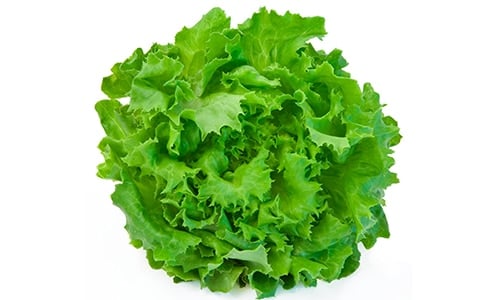 Cruciferous vegetables are a great foundation for a healthy digestive tract. These include broccoli, Brussels sprouts, kale, and collard greens. They’re rich in fiber and packed with healthy vitamins and minerals.
When it comes to the gut, these fiber-packed greens help regulate digestion and allow healthy bacteria to flourish. One study found a compound in green cruciferous veggies boosts the immune system and activates a gene called T-bet. Researchers in Australia found this gene lives in the gut and actually triggers the growth of healthy bacteria in the GI.
Although cruciferous veggies have some great nutrients to feed your GI, they also contain a compound called cellulose that our bodies naturally have a tough time digesting. That’s why for some, eating raw veggies can lead to gas, bloating, or abdominal pain. If your diet doesn’t currently include many greens, or if you find these are rough on your GI, there are a few things you can do. Incorporating raw greens into your diet gradually over time, and cooking or fermenting your veggies can all be beneficial to ease their route in the digestive tract while still nourishing your colon.
For some, taking a daily digestive enzyme that includes cellulase, an enzyme produced naturally by intestinal bacteria to digest cellulose, can help break down the fiber in cruciferous veggies to make it easier on your GI tract.
Cruciferous vegetables are a great foundation for a healthy digestive tract. These include broccoli, Brussels sprouts, kale, and collard greens. They’re rich in fiber and packed with healthy vitamins and minerals.
When it comes to the gut, these fiber-packed greens help regulate digestion and allow healthy bacteria to flourish. One study found a compound in green cruciferous veggies boosts the immune system and activates a gene called T-bet. Researchers in Australia found this gene lives in the gut and actually triggers the growth of healthy bacteria in the GI.
Although cruciferous veggies have some great nutrients to feed your GI, they also contain a compound called cellulose that our bodies naturally have a tough time digesting. That’s why for some, eating raw veggies can lead to gas, bloating, or abdominal pain. If your diet doesn’t currently include many greens, or if you find these are rough on your GI, there are a few things you can do. Incorporating raw greens into your diet gradually over time, and cooking or fermenting your veggies can all be beneficial to ease their route in the digestive tract while still nourishing your colon.
For some, taking a daily digestive enzyme that includes cellulase, an enzyme produced naturally by intestinal bacteria to digest cellulose, can help break down the fiber in cruciferous veggies to make it easier on your GI tract.
2. Chia & Flax Seeds for More Fiber
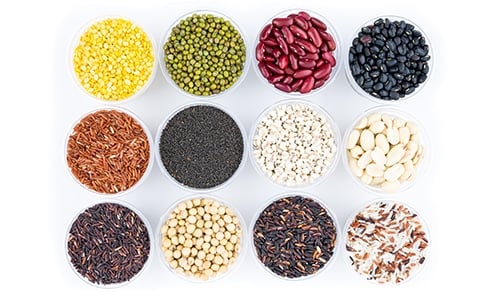 Chia seeds are rich in antioxidants, omega-3 fatty acids, minerals, and vitamins for a plethora of health benefits. For digestion, the best nutrients here will be fiber: just two tablespoons of chia seeds supply 10 grams of fiber. Flaxseeds additionally are a great source of dietary fiber, helping to increase bowel movements and prevent constipation.
When it comes to fiber, your body needs both insoluble (meaning it doesn’t dissolve in water and isn’t broken down in your GI) and soluble (which does dissolve in water). Dietary fiber is essential to healthy digestion, and it’s a nutrient many of us do not get enough of. It helps keep bowel movements regular, bulks up stools, prevents constipation, and flushes out waste. Studies show that the way bacteria digests fiber also helps produce short-chain fatty acids that are healthy for the colon.
Because of the way it works in the body, it’s important to drink plenty of water along with fibrous foods in order flush out waste and prevent constipation. However, too much fiber can lead to loose stools, bloating, or diarrhea—so ensure you’re always consuming in moderation.
Chia seeds are rich in antioxidants, omega-3 fatty acids, minerals, and vitamins for a plethora of health benefits. For digestion, the best nutrients here will be fiber: just two tablespoons of chia seeds supply 10 grams of fiber. Flaxseeds additionally are a great source of dietary fiber, helping to increase bowel movements and prevent constipation.
When it comes to fiber, your body needs both insoluble (meaning it doesn’t dissolve in water and isn’t broken down in your GI) and soluble (which does dissolve in water). Dietary fiber is essential to healthy digestion, and it’s a nutrient many of us do not get enough of. It helps keep bowel movements regular, bulks up stools, prevents constipation, and flushes out waste. Studies show that the way bacteria digests fiber also helps produce short-chain fatty acids that are healthy for the colon.
Because of the way it works in the body, it’s important to drink plenty of water along with fibrous foods in order flush out waste and prevent constipation. However, too much fiber can lead to loose stools, bloating, or diarrhea—so ensure you’re always consuming in moderation.
3. Fruits & Vegetables for Prebiotics
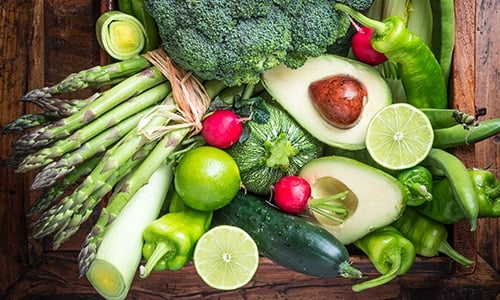 Prebiotics differ from probiotics in that they contain indigestible nutrients that promote the growth and success of the healthy bacteria (hence the pre). Probiotics are those beneficial bacteria that support your digestive system, so protecting their growth and diversity is an important job! Prebiotics and probiotics work synergistically to promote the well being of your GI and keep your body healthy.
Some especially gut-friendly fruits and veggies include the prebiotics found in asparagus, artichokes, mushrooms, onions, apples, and bananas. Inulin, a nutritional component that occurs naturally in many of these fruits and veggies, is full of fiber and low in calories. The fiber in inulin is soluble, and dissolving in the stomach to slow digestion and increase fullness.
Prebiotics differ from probiotics in that they contain indigestible nutrients that promote the growth and success of the healthy bacteria (hence the pre). Probiotics are those beneficial bacteria that support your digestive system, so protecting their growth and diversity is an important job! Prebiotics and probiotics work synergistically to promote the well being of your GI and keep your body healthy.
Some especially gut-friendly fruits and veggies include the prebiotics found in asparagus, artichokes, mushrooms, onions, apples, and bananas. Inulin, a nutritional component that occurs naturally in many of these fruits and veggies, is full of fiber and low in calories. The fiber in inulin is soluble, and dissolving in the stomach to slow digestion and increase fullness.
4. Fermented Vegetables
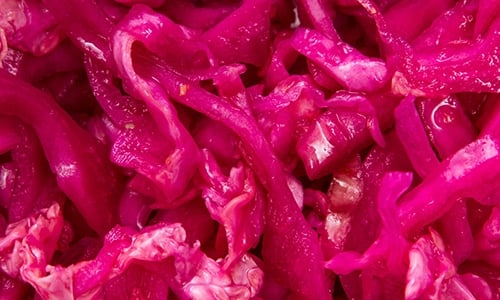 We spoke at length about the plethora of probiotic probiotic health benefits and how to choose the best probiotic for you in the past. Probiotics help keep your digestion stable and supports the absorption of nutrients. They also help supported a disrupted microbiome after taking antibiotics and can support everything from immunity to healthy skin or even vaginal health.
Fermented foods contain lactic acid-producing bacteria, which survive the acidic digestive process into your colon. For plant-based options, look to fermented veggies for natural probiotic foods. (We have a complete guide to the best and worst probiotic foods here.) Go for sauerkraut, a fermented cabbage—but avoid the canned kind, as it’s pasteurized and the healthy bacteria is killed off. Also try kimchi—a staple at any Korean BBQ—a spicy fermented cabbage and rich probiotic. It’s particularly beneficial for your immune system. Kombucha, a fermented tea, is another popular probiotic.
We spoke at length about the plethora of probiotic probiotic health benefits and how to choose the best probiotic for you in the past. Probiotics help keep your digestion stable and supports the absorption of nutrients. They also help supported a disrupted microbiome after taking antibiotics and can support everything from immunity to healthy skin or even vaginal health.
Fermented foods contain lactic acid-producing bacteria, which survive the acidic digestive process into your colon. For plant-based options, look to fermented veggies for natural probiotic foods. (We have a complete guide to the best and worst probiotic foods here.) Go for sauerkraut, a fermented cabbage—but avoid the canned kind, as it’s pasteurized and the healthy bacteria is killed off. Also try kimchi—a staple at any Korean BBQ—a spicy fermented cabbage and rich probiotic. It’s particularly beneficial for your immune system. Kombucha, a fermented tea, is another popular probiotic.
5. Cultured Products for Dairy-Based Probiotic Foods
 In addition to fermented vegetables, cultured dairy products such as yogurt, kefir, and cheese are probiotic foods to support digestion. Kefir—a drinkable yogurt—contains complex carbs that feed healthy bacteria. Greek yogurt is additionally packed with protein to help you feel fuller, longer. Whenever buying from a supermarket, look for plain flavors with little to no added sugar.
Also, make sure live and active cultures are actually included on the label. Heat processing destroys both bad and good bacteria. Thus, the pasteurization process in yogurt will kill off the good guys unless they’re added in afterwards.
In addition to fermented vegetables, cultured dairy products such as yogurt, kefir, and cheese are probiotic foods to support digestion. Kefir—a drinkable yogurt—contains complex carbs that feed healthy bacteria. Greek yogurt is additionally packed with protein to help you feel fuller, longer. Whenever buying from a supermarket, look for plain flavors with little to no added sugar.
Also, make sure live and active cultures are actually included on the label. Heat processing destroys both bad and good bacteria. Thus, the pasteurization process in yogurt will kill off the good guys unless they’re added in afterwards.
DIY Yogurt Recipe to Support Healthy Digestion
To create your own cultured dairy at home, try this DIY recipe for yogurt.
PREP
15
15
COOK
360
360
SERVES
8
8
INGREDIENTS
- 1/2 gallon 2% milk
- 1/2 cup commercial yogurt with active cultures (needed as a starter)
SUPPLIES
- Thermometer
- Large saucepan with lid
INSTRUCTIONS
- Place the milk in a saucepan over medium heat. Bring the milk to just below boiling, at 200° F. Stir the milk gently to make sure the bottom doesn’t burn and the milk doesn’t boil over.
- Let milk cool, stirring occasionally, until it reaches to 115° F. You can do this on the counter or by placing the bottom of the saucepan in an ice bath.
- Remove one cup of warm milk and add to a small bowl with the yogurt starter. Whisk until smooth and yogurt is dissolved. Pour the yogurt back into the culture and stir together. Cover the saucepan oven with the lid and place the whole pot in a turned-off oven—turn on the oven light or wrap the pot in towels to keep the milk warm as it sets (ideally around 110° F, though some variance is fine). (You can also make the yogurt in a dehydrator left at 110° F or with a yogurt maker.)
- Let yogurt sit for at least six hours or overnight. The longer yogurt sits, the thicker and more tart it becomes. If this is your first time making yogurt, start checking it after 5 to 6 hours and stop when it reaches a flavor and consistency you like. Avoid jostling or stirring the yogurt until it has fully set.
- Remove the yogurt from the oven and transfer to storage containers. It will keep for about two weeks in the refrigerator.
More like this


